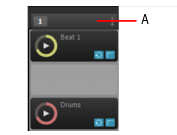






to open the Matrix Options dialog box, then click the Import all audio as GrooveClips check box.
The first pattern is assigned to the target cell, and any additional patterns are assigned to subsequent rows below the target cell.The first pattern is assigned to the target cell, and any additional patterns are assigned to subsequent columns the right of the target cell.



in the Matrix view toolbar and select Clear All Cells from the drop-down menu.
When you trigger a cell or column, playback starts after the amount of time that is selected in the Cell Trigger Timemenu in the Matrix view toolbar.








, patterns always start from the beginning. In Offset to Now Time mode
, patterns synchronize to the project’s Now time.






in the Matrix view toolbar is disabled, it will automatically be enabled when a cell is in MIDI Learn mode.





in the Matrix view toolbar and select Clear All MIDI Learn from the drop-down menu.














. Doing so will bypass the assigned track’s MIDI processing, such as MIDI FX, Arpeggiator, volume, etc., and send the row directly to the assigned soft synth or hardware output.
A. Click the row’s Direct Mode button to bypass all MIDI track processingRows that contain audio patterns can be assigned to any available audio track, and rows that contain MIDI patterns can be assigned to MIDI tracks.A. Click arrow to reassign a row to a different track
Tip - Searching Documentation
Tip: To search for a specific topic, type your search query in the Search Cakewalk.com field at the top right of this page.
When the search results appear, click which product's documentation you would like to search to filter the search results further.
Note - Using Offline Help
Note: If you prefer to always use offline Help, go to Edit > Preferences > File > Advanced in your Cakewalk software and select Always Use Offline Help.
If you are not connected to the internet, your Cakewalk software will default to showing offline help until an internet connection becomes available.









